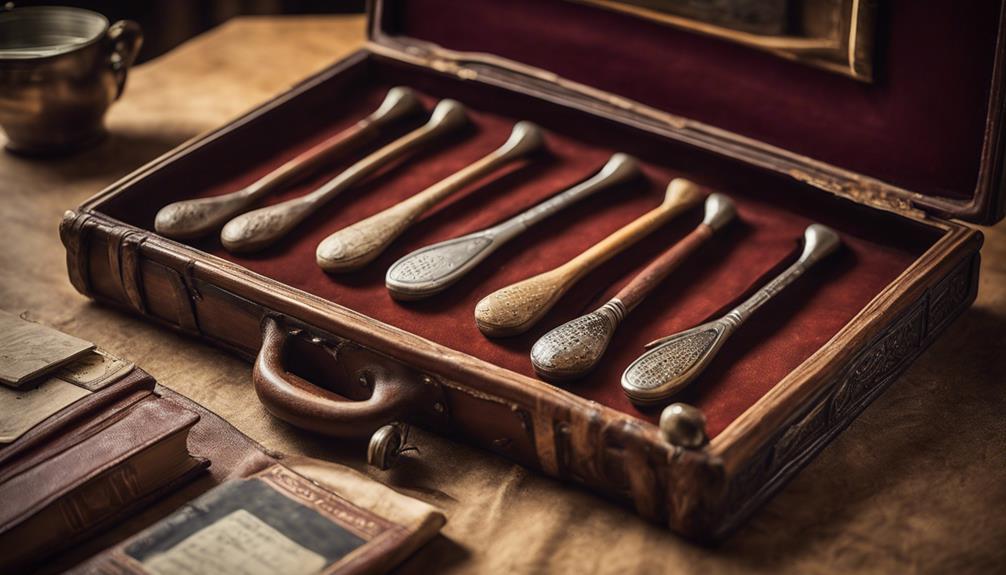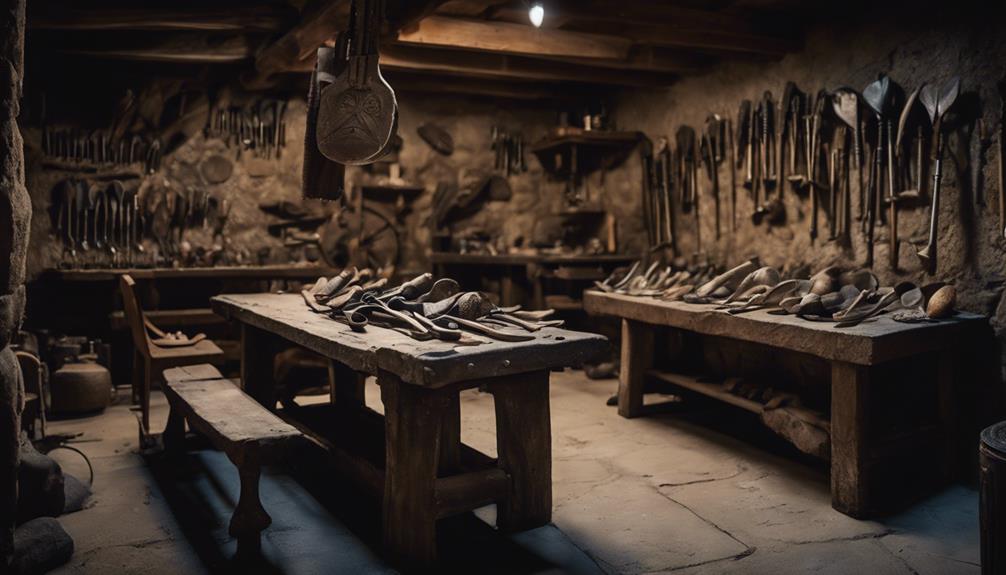- 7 Top Flite Golf Clubs XL for Improved Performance - September 28, 2024
- Top Flite Golf Clubs: Top 5 Reasons to Choose Them - September 28, 2024
- Top 3 Golf Club Fitters for a Perfect Swing - September 28, 2024
You'll discover that antique golf clubs were known by names like Mashie, Niblick, and Spoon, which reflected the craftsmanship of early club makers and added a unique charm to the game. Traditional sets included clubs like Baffie, Cleek, and Brassie, each with its own distinct character. These names not only evoke a sense of history but also highlight the skill of early club makers. As you explore further, you'll uncover the fascinating story of how these antique clubs evolved into the standardized sets we use today, and the intricate nuances that separate them.
Key Takeaways
- Ancient golf clubs had names like Mashie, Niblick, and Spoon, reflecting the craftsmanship of early club makers.
- Traditional sets included clubs like Baffie, Cleek, and Brassie, which added charm to the game and highlighted its history.
- Brassie was similar to a modern 3-wood, Spoon functioned like a 5-wood, and Cleek was akin to a driving iron.
- Mashie Iron resembled a 4-iron, and Baffie served as an equivalent to a higher-lofted wood or hybrid club.
- Antique club names evolved into standardized club names and numbers, replacing traditional named clubs with modern sets.
Historical Names of Golf Clubs
As you explore further into the history of golf clubs, you'll uncover that ancient clubs were distinguished by unique names like Mashie, Niblick, and Spoon, each serving specific purposes in the game. These old names reflect the early days of antique golf, where clubs were crafted with precision and care.
Historical names like Baffie, Cleek, and Brassie were common in early golf sets, showcasing the evolution of golf club terminology. You'll notice that traditional sets included clubs like the Play Club, Mashie Iron, and Niblick, each with its own distinct characteristics. These historical names not only add charm to the game but also highlight the craftsmanship of early club makers.
In the world of obsolete golf, names like Massue and Jigger were once an integral part of the game, telling a story of innovation and creativity. As you dive deeper into the history of golf clubs, you'll appreciate the significance of these historical names and the role they played in shaping the game as it's recognized today.
Evolution of Club Standardization
You'll find that the charming, unique names of antique golf clubs gave way to standardized club names and numbers as the game evolved, marking a significant shift towards modernization.
As you explore the history of golf, you'll notice that early clubs lacked uniformity, with names like mashie, niblick, and cleek used to identify them. However, this changed in the late 1930s when modern sets with standardized club names and numbers became the norm.
The transformation was facilitated by the replacement of Hickory Shafted clubs with steel and graphite shafts, which allowed for greater consistency and precision. This standardization led to the disappearance of named antique clubs, replaced by numbered modern clubs.
A set of irons, for instance, now features numbered clubs rather than unique names like baffies and play clubs. As you investigate further into the history of golf, you'll appreciate how the evolution of club standardization has shaped the game into what it's today.
Antique Club Names and Equivalencies

In your exploration of antique golf club sets, understanding the equivalencies between old club names and their modern counterparts is essential to help you better appreciate the evolution of the game.
You'll find that old golf clubs had distinct names that often reflected their playing characteristics. The Brassie, for example, was similar to a modern 3-wood, while the Spoon functioned like a 5-wood in historical golf club sets.
The Cleek, akin to a driving iron, had a role comparable to modern 1-irons and 2-irons in antique golf club collections. The Mashie Iron resembled a 4-iron, and the Mashie was like a 5-iron in the lineup of old golf clubs.
Wooden Cleeks were used like modern 2-irons, adding to the variety of antique clubs that have since been replaced by numbered clubs.
Lastly, the Baffie, also known as a baffing spoon, served as an equivalent to a higher-lofted wood or hybrid club in traditional golf club terminology.
Misleading Club Comparisons and Dating
When dating antique golf clubs, beware that comparisons to modern clubs can be misleading due to the variables that affected the original design and construction of historical clubs. You might assume that a higher-lofted wood from the 1800s is equivalent to a modern club with a similar loft angle, but that's not always the case.
| Club Type | Ancient Loft Angle | Modern Loft Angle |
|---|---|---|
| Driver | 10-12° | 8-10° |
| Brassie | 15-18° | 12-15° |
| Spoon | 20-22° | 18-20° |
| Putter | 0-2° | 0-2° |
The club face and overall design of ancient clubs were often handcrafted by blacksmiths, resulting in variations that make direct comparisons challenging. Besides, standardization in loft angles in modern clubs has impacted the accuracy of comparing ancient and modern clubs, affecting equivalences. Be cautious when relying on charts published in different eras, as they may have discrepancies. By understanding these variables, you can more accurately date and appreciate your antique golf clubs.
Fossil Evidence and Craftsmanship Variance

As you scrutinize ancient golf clubs, you'll observe distinctive designs that distinguish them from their modern counterparts. The craftsmanship of these clubs, frequently hand-forged by skilled blacksmiths, introduced variations in shape and loft angle, creating each club a unique artifact.
It's vital to take these variations into account when analyzing fossil evidence, as they can greatly affect our comprehension of ancient clubs and their intentions.
Unique Ancient Designs
Examining fossil evidence of ancient golf clubs reveals a striking diversity of designs, with brassies and spoons showcasing unique shapes and loft angles that differ significantly from their modern counterparts.
As you explore the world of ancient clubs, you'll notice that each piece was meticulously crafted by skilled blacksmiths, resulting in one-of-a-kind designs that defy contemporary standards. Unlike mass-produced modern clubs, ancient clubs were shaped by hand, leading to distinct variations in shape, size, and loft angle.
This individual craftsmanship makes it challenging for experts to pinpoint a modern equivalent, as each ancient club was a singular creation. The absence of standardized designs and manufacturing processes meant that every ancient club was a masterpiece of its own, with characteristics that set it apart from others.
Craftsmanship Variance Matters
Fossil evidence of ancient golf clubs, like brassies and spoons, reveals a remarkable craftsmanship variance, with each club's unique shape and loft angle a tribute to the skillful hands of blacksmiths and artisans who crafted them. You can appreciate the individual craftsmanship that went into creating these ancient clubs, which differed notably from their modern equivalents.
| Ancient Club | Modern Equivalent |
|---|---|
| Brassie | 2-Wood |
| Spoon | 3-Wood |
| Baffy | 5-Iron |
| Mashie | 5-Iron |
| Niblick | 9-Iron |
As you examine the table, you'll notice that experts may disagree on which modern club corresponds to an ancient one due to design differences. This is because ancient clubs were crafted individually, resulting in variations in shapes and loft angles. In contrast, modern mass-production techniques have standardized club designs and loft angles, replacing individual craftsmanship. The introduction of matched sets in the 1920s further solidified this shift. By understanding the craftsmanship variance of ancient clubs, you'll gain a deeper appreciation for the evolution of golf clubs and the skillful hands that shaped the game.
Traditional Club Names and Manufacturing
As you explore the world of traditional golf clubs, you'll uncover the art of manufacturing that went into creating these unique instruments. Frequently, skilled blacksmiths handcrafted traditional golf clubs, carefully determining loft angles by eye or protractor to craft one-of-a-kind instruments for the game. This level of craftsmanship led to variations in shapes and loft angles, making each club truly distinct.
The names of these traditional clubs, such as Mashie-niblick and sand wedge, originated from their distinct designs and purposes. The clubfaces of these ancient clubs featured textured surfaces with embossed dots, which underwent a tempering process to prevent cracks.
Some key aspects of traditional club manufacturing include:
- Each club was individually crafted, resulting in unique characteristics.
- Caddies carried different clubs for players, each serving a specific utility on the course.
- The tempering process ensured the clubfaces remained durable and crack-resistant.
Understanding the traditional club names and manufacturing process gives you a deeper appreciation for the game and the craftsmanship that went into creating these iconic instruments.
Frequently Asked Questions
What Is an Old Golf Club Called?
You're likely wondering what an old golf club is called; well, you'll hear terms like Mashie, Niblick, or Cleek, which are vintage club terminology used to describe classic golfing equipment, boasting antique club names that reflect historical golf club terms.
What Is the Old Name for 5 Irons?
As you explore golf's rich history, you'll discover that the old name for a 5 iron is like a hidden gem – it's called a 'Spoon', a historical term that reveals the evolution of golf club nomenclature and classic iron design.
What Do Golfers Call Their Clubs?
You refer to your clubs by their nicknames, using golfer lingo like "sticks" or "tools of the trade," which encompasses equipment terminology, including historical club names like Mashie and Brassie.
How to Identify Old Golf Clubs?
When you're identifying old golf clubs, look for unique markings, consider their historical significance, and assess their antique value, as these factors contribute to their collectible appeal and help you distinguish genuine vintage treasures from reproductions.
Conclusion
As you grasp the worn leather grip of a vintage driver, the whispers of forgotten names echo through the centuries: 'Baffy' and 'Spoon' resonate like echoes in a forgotten chamber.
Like an archaeologist unearthing ancient artifacts, you've uncovered the hidden language of golf's past.
The clubs, once mysterious relics, now shine with a newfound luster, their antique names and equivalencies illuminating the winding path of golf's evolution.



